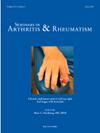Quantification of coronary artery calcification in systemic sclerosis using visual ordinal and deep learning scoring: Association with systemic sclerosis clinical features
IF 4.6
2区 医学
Q1 RHEUMATOLOGY
引用次数: 0
Abstract
Objective
To investigate the association between systemic sclerosis (SSc) clinical features and the extent and progression of coronary artery calcifications.
Methods
We conducted a single-center retrospective cohort study of patients with SSc. In our primary aim, we investigated the association between SSc clinical features and the annual progression of coronary artery calcium (CAC) scores quantified using the visual ordinal scoring method. In our secondary aim, we utilized DeepCAC, a deep learning-based method, to quantify coronary artery calcifications (“deep learning CAC score”), and explored its association with SSc clinical features.
Results
Eighty-six SSc patients were included in the primary aim and 171 in the secondary aim. SSc disease duration was inversely associated with annual ordinal CAC score progression in the demographics-adjusted model (coefficient = -0.004, 95 % CI -0.006 to -0.001, p-value = 0.01) and the demographics- and cardiovascular (CV) risk factor-adjusted model (coefficient = -0.004, 95 % CI -0.008 to -0.0004, p-value = 0.03). The presence of "fingertip ischemic ulcers or digital pitting scars" (demographics-adjusted model: coefficient = 1.07, 95 % CI 0.29 to 1.85, p < 0.01; demographics- and CV risk factor-adjusted model: coefficient = 1.39, 95 % CI 0.43 to 2.34, p < 0.01) and Group 1 pulmonary hypertension (demographics-adjusted model: coefficient = 1.34, 95 % CI 0.34 to 2.35, p < 0.01; demographics- and CV risk factor-adjusted model: coefficient = 1.52, 95 % CI 0.38 to 2.65, p < 0.01) were both associated with the deep learning CAC score.
Conclusion
Our results suggest that the progression of coronary artery calcification accelerates early during the SSc disease course and that severe microvasculopathy may be a risk factor for atherosclerotic CVD.
使用视觉序数和深度学习评分量化系统性硬化症的冠状动脉钙化:与系统性硬化症临床特征的关联
目的探讨系统性硬化症(SSc)临床特征与冠状动脉钙化程度及进展的关系。方法对SSc患者进行单中心回顾性队列研究。在我们的主要目的中,我们研究了SSc临床特征与冠状动脉钙(CAC)评分年度进展之间的关系,该评分使用视觉顺序评分法进行量化。在我们的次要目标中,我们利用基于深度学习的方法DeepCAC来量化冠状动脉钙化(“深度学习CAC评分”),并探讨其与SSc临床特征的关系。结果86例SSc患者纳入主要目的,171例纳入次要目的。在人口统计学校正模型(系数= -0.004,95% CI -0.006至-0.001,p值= 0.01)和人口统计学和心血管(CV)危险因素校正模型(系数= -0.004,95% CI -0.008至-0.0004,p值= 0.03)中,SSc病程与CAC年度有序评分进展呈负相关。“指尖缺血性溃疡或数字凹陷疤痕”的存在(人口统计学调整模型:系数= 1.07,95% CI 0.29至1.85,p <;0.01;人口统计学和CV危险因素调整模型:系数= 1.39,95% CI 0.43至2.34,p <;0.01)和第一组肺动脉高压(人口统计学校正模型:系数= 1.34,95% CI 0.34 ~ 2.35, p <;0.01;人口统计学和CV危险因素调整模型:系数= 1.52,95% CI 0.38 - 2.65, p <;0.01)均与深度学习CAC评分相关。结论在SSc发病过程中,冠状动脉钙化的进程在早期加速,严重的微血管病变可能是动脉粥样硬化性CVD的危险因素。
本文章由计算机程序翻译,如有差异,请以英文原文为准。
求助全文
约1分钟内获得全文
求助全文
来源期刊
CiteScore
9.20
自引率
4.00%
发文量
176
审稿时长
46 days
期刊介绍:
Seminars in Arthritis and Rheumatism provides access to the highest-quality clinical, therapeutic and translational research about arthritis, rheumatology and musculoskeletal disorders that affect the joints and connective tissue. Each bimonthly issue includes articles giving you the latest diagnostic criteria, consensus statements, systematic reviews and meta-analyses as well as clinical and translational research studies. Read this journal for the latest groundbreaking research and to gain insights from scientists and clinicians on the management and treatment of musculoskeletal and autoimmune rheumatologic diseases. The journal is of interest to rheumatologists, orthopedic surgeons, internal medicine physicians, immunologists and specialists in bone and mineral metabolism.

 求助内容:
求助内容: 应助结果提醒方式:
应助结果提醒方式:


